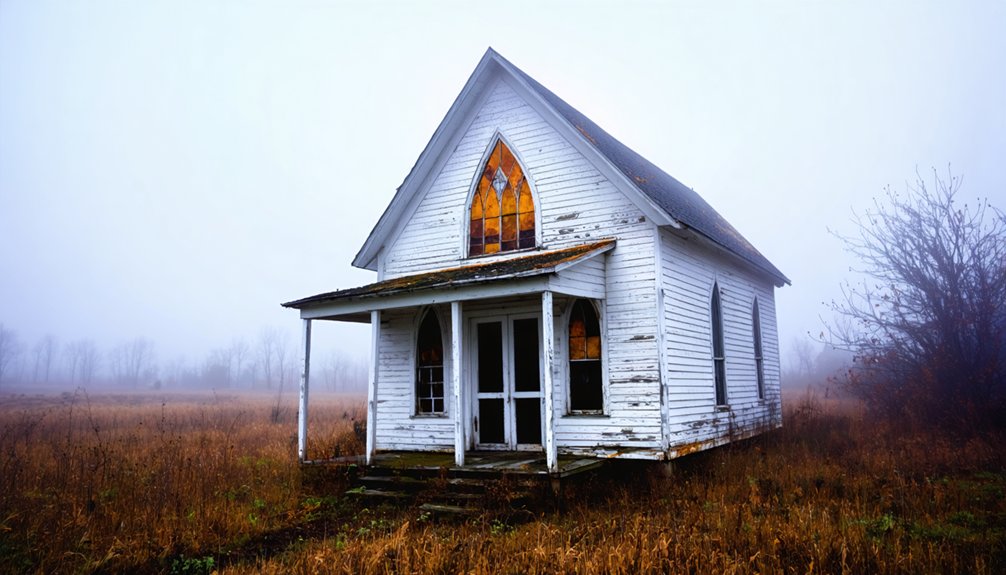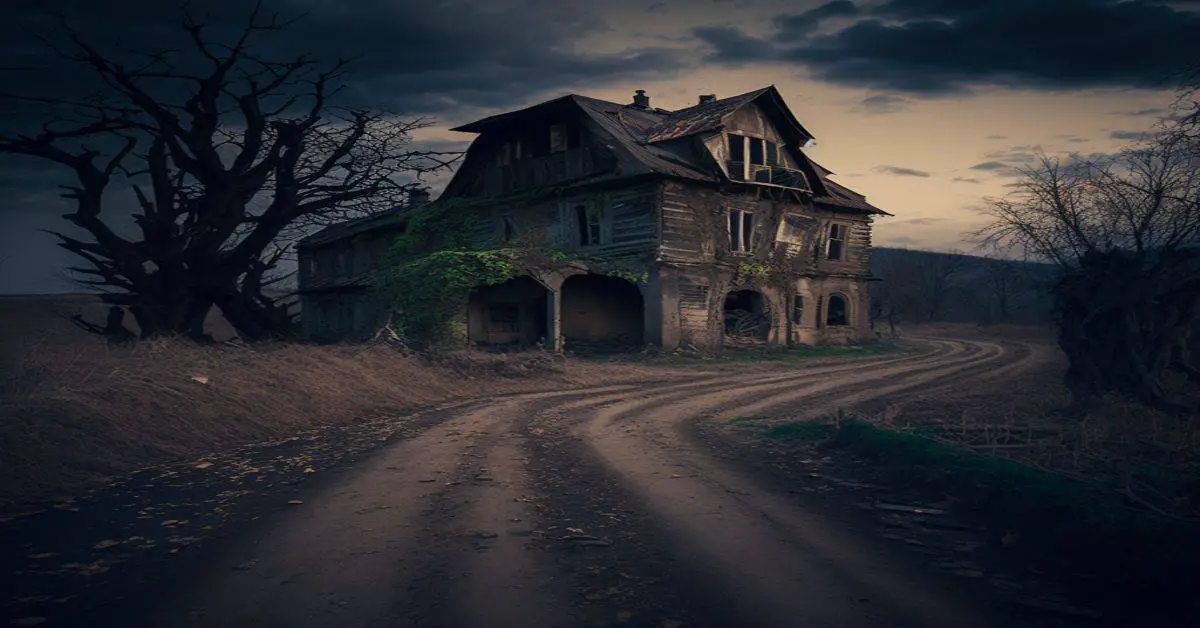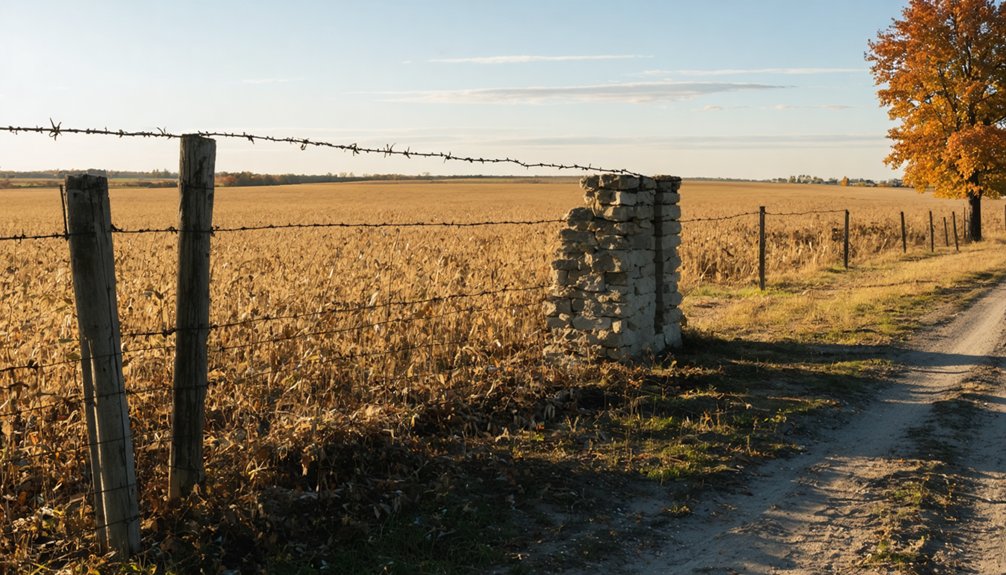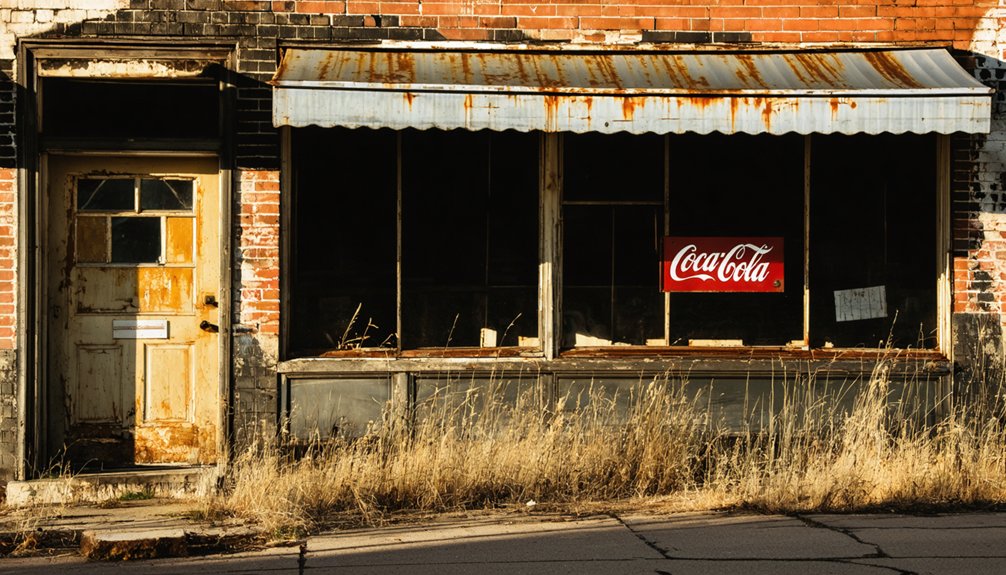You’ll find Papsville’s haunting remnants along the former DuPage River rail corridor, where a once-bustling railroad town thrived in the late 1800s. The community’s prosperity relied heavily on manufacturing and rail connections until major route changes in the 1930s triggered its decline. Today, deteriorating structures and scattered historical records offer glimpses into its past, while preservation challenges have left many of Papsville’s secrets waiting to be uncovered.
Key Takeaways
- Papsville transformed into a ghost town after major rail routes were redirected in the 1930s, causing economic collapse and population exodus.
- The town’s decline accelerated due to manufacturing sector losses, reduced services, and younger residents moving to larger cities.
- Limited historical documentation and architectural preservation make Papsville’s ghost town status difficult to fully document or study.
- Unlike neighboring communities, Papsville lacks documented ghost stories or paranormal activities despite its abandoned status.
- Infrastructure deterioration, including shuttered buildings and declining essential services, exemplifies Papsville’s current ghost town condition.
Origins and Early Settlement
When Joseph Naper established his settlement along the DuPage River in 1831, he laid the foundation for what would become a thriving community 28 miles west of Chicago.
The Papsville origins trace back to settlers from northeastern states like New York and Pennsylvania, who were drawn to the area’s strategic location along stage routes between Chicago and Galena.
You’ll find that early settlement patterns revolved around agricultural development and commerce, with settlers building sawmills and gristmills to support the growing population. The community’s religious life flourished with seven early churches established, demonstrating the settlers’ commitment to their faith. Today, one historic church remains particularly notable as the site of ghostly bride sightings, according to local paranormal investigators.
By the 1840s, German, English, and Scottish immigrants joined the community, establishing farms and businesses.
A wave of European newcomers brought fresh energy to the settlement, building agricultural and commercial enterprises throughout the 1840s.
The Pre-Emption House hotel emerged by 1832, while the Southwest Plank Road’s construction in 1851 strengthened regional connections, transforming the settlement from a frontier outpost into an incorporated village by 1857.
The Rise and Fall of a Railroad Town
You’ll find that Papsville’s trajectory closely mirrored the rise of many Midwestern railroad settlements, with its initial growth spurred by the arrival of rail service in the late 1800s.
During its peak industrial period, the town supported several manufacturing operations and boasted a bustling commercial district centered around the railway depot. Similar to how Chicago, Burlington & Quincy transformed Naperville’s economy, Papsville’s industrial success was directly tied to its rail connections. The railway’s presence enabled trains to operate at 80 mph speeds through the region, facilitating rapid transportation of goods and passengers.
The community’s ultimate decline began when major rail routes were redirected away from Papsville in the early 20th century, leading to the exodus of businesses and residents that would eventually render it a ghost town.
Early Railway Settlement Beginnings
Like many American towns born from the railroad era, Papsville, Illinois emerged as a direct result of the expanding railway network that transformed the nation’s landscape during the mid-1800s.
As railroad connections pushed westward, you’d have witnessed how these essential transportation arteries shaped settlement patterns, turning previously empty prairies into bustling communities virtually overnight.
The strategic placement of Papsville along the rail line made it an attractive location for early settlers seeking economic opportunities.
You’ll find that the town’s initial growth mirrored the typical pattern of railroad settlements – first came the station, then the warehouses, followed by merchants and service providers who recognized the potential of this transportation hub.
Local businesses quickly capitalized on the newfound access to distant markets, following the example of other DuPage County communities that used the six railroads to transport agricultural products and manufactured goods.
Peak Industrial Development Era
During the early 20th century, Papsville’s industrial landscape transformed from its agricultural roots into a diverse manufacturing powerhouse.
You’ll find evidence of industrial innovation throughout this period, as the city leveraged its strategic rail connection to the Chicago, Burlington & Quincy Railroad for unprecedented growth. Similar to how Northern Illinois Gas sparked development along the I-88 corridor in 1963, Papsville’s industrial evolution began with key corporate relocations. The tragic train disaster of 1946 that claimed 45 lives marked a pivotal moment in the city’s industrial era.
The community’s resilience manifested through four key developments:
- Kroehler Manufacturing Co.’s emergence as the dominant employer, revolutionizing furniture production and distribution.
- Stone quarries expanding operations to meet Chicago’s post-fire reconstruction demands.
- Steel and copper manufacturing facilities establishing modern industrial operations.
- Stenger Brewery scaling regional distribution via rail networks.
Decline After Route Changes
While Papsville once thrived as a bustling railroad hub, the community’s fate changed dramatically when major rail companies began rerouting their tracks to serve larger population centers in the 1930s.
You’d have witnessed the town’s transportation evolution firsthand as passenger service dwindled and freight traffic disappeared. Despite initial community resilience, Papsville’s economic foundation crumbled as hotels, diners, and warehouses shuttered their doors. Much like the EMD train locomotives that once thundered through town, progress left Papsville behind.
The signal control systems that could have prevented accidents were never installed, as seen in the tragic 1946 Naperville crash nearby.
The town’s isolation deepened when faster diesel trains bypassed the community entirely, and improved automobile infrastructure drew activity elsewhere. Property values plummeted while young residents fled to urban areas, leaving an aging population behind.
With each passing year, empty buildings deteriorated, and essential services vanished until Papsville ultimately succumbed to ghost town status.
Architectural Remnants and Lost Structures
Despite extensive research efforts, little tangible evidence remains of Papsville’s architectural heritage, making it one of Illinois’ most enigmatic ghost towns.
The architectural significance of this forgotten settlement has proven challenging to document, with no preserved structures or historical markers to guide modern exploratory efforts. The lack of documentation stands in stark contrast to sites like Naper Settlement, where historical buildings have been carefully preserved.
If you’re interested in understanding Papsville’s physical remnants, you’ll find that historical records reveal four key challenges:
- No documented preservation initiatives or community engagement efforts exist
- The materials and construction methods used in original buildings remain unknown
- Historical maps and records haven’t identified specific lost structures
- Archaeological studies haven’t been conducted to uncover potential remnants
The absence of tangible evidence and historical documentation has left Papsville’s architectural legacy shrouded in mystery, making it a compelling case study in historical preservation challenges.
Local Legends and Paranormal Tales
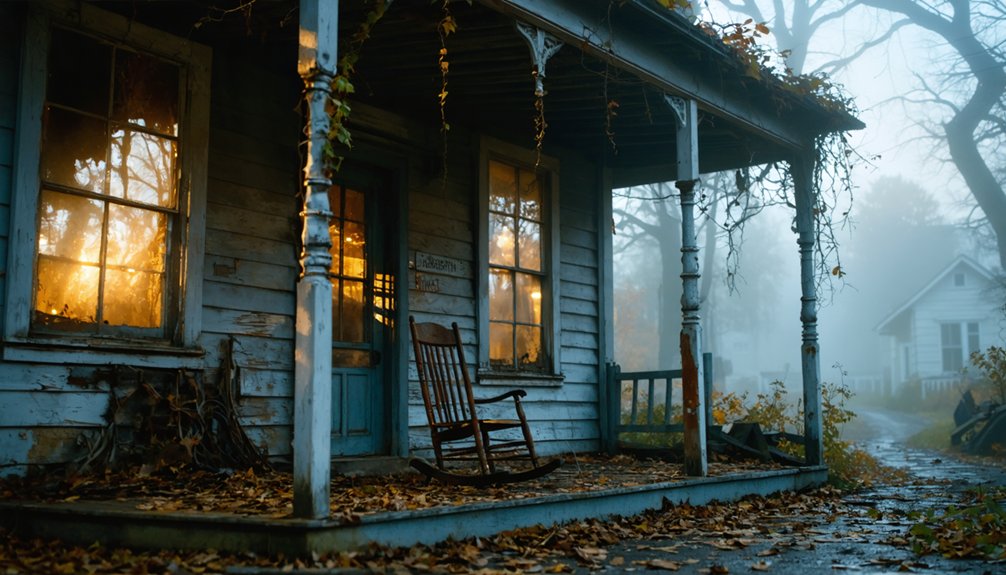
Unlike its neighboring communities that boast rich paranormal traditions, Papsville stands apart for its notable absence of documented ghost stories and local legends.
While nearby Naperville captivates visitors with ghostly encounters at Central Park and the historic Naper Settlement, Papsville’s paranormal landscape remains mysteriously quiet.
You won’t find organized ghost tours or paranormal investigations in Papsville, contrasting sharply with the popular lantern-lit walks and EMF-equipped expeditions of surrounding towns.
This absence of folklore significance isn’t necessarily due to a lack of supernatural activity – rather, it stems from limited historical documentation of the area.
While Illinois boasts famous haunted locations like Bachelor’s Grove Cemetery, Papsville’s paranormal potential remains untapped, waiting for someone to uncover and share whatever secrets its abandoned structures might hold.
Historical Significance in Illinois
Throughout Illinois’s rich architectural legacy, Naperville stands as a tribute to preserved Midwestern development, with its 613 historic buildings forming an impressive district that overshadows Papsville’s minimal historical footprint.
When you explore Illinois’s cultural heritage, you’ll find historical landmarks that tell compelling stories of pioneer spirit and industrial progress.
- Early civic importance emerges through preserved structures like the Paw Paw Station (1833), the county’s first public building.
- Educational heritage thrives at North Central College, featuring John M. Van Osdel’s 1870 architectural designs.
- Industrial growth shines through the Kroehler Manufacturing Company building (1905).
- Working-class history lives on in properties like the Hammerschmidt family’s 122 South Brainard (1874).
These preserved sites showcase Illinois’s transformation from frontier settlement to thriving cultural center.
Economic Factors Behind Abandonment

When Papsville’s primary manufacturing sector began declining in the mid-20th century, a cascade of economic challenges led to its eventual abandonment.
You’ll find that this economic decline was compounded by a lack of industry diversification and the town’s heavy reliance on a single manufacturing base, making it particularly vulnerable when global competition intensified.
The town’s isolation from major transportation routes further complicated its ability to attract new businesses, while urban migration drew younger residents to larger cities offering better job prospects and modern amenities.
You can trace how deteriorating infrastructure and limited government support accelerated the exodus, creating a downward spiral where declining tax revenues made it increasingly difficult to maintain essential services.
The combination of these factors ultimately sealed Papsville’s fate as another Illinois ghost town.
Preservation Challenges and Documentation
You’ll find significant gaps in Papsville’s historical records, with limited photographs and documentation from its early 20th-century period making accurate preservation difficult.
The site’s remote location and deteriorating infrastructure create substantial challenges for preservation teams attempting to access and maintain the remaining structures.
These issues are compounded by competing priorities between various stakeholders, including private property owners, local government entities, and preservation groups who often disagree on conservation approaches and resource allocation.
Historical Records Gap
Despite extensive historical documentation efforts in DuPage County, Papsville’s records suffer from significant preservation challenges and archival fragmentation.
You’ll find that historical inaccuracies and limited archival access have created substantial gaps in understanding this ghost town’s past.
The key issues affecting Papsville’s historical record include:
- Physical documents are scattered across multiple collections, with materials divided between local libraries, museums, and private holdings.
- Many original records face ongoing deterioration due to inadequate preservation funding.
- Census data and early atlases contain errors or omissions specific to smaller settlements.
- Oral histories, essential for preserving local knowledge, weren’t formally recorded before elderly residents passed.
These gaps in documentation make it challenging for researchers to piece together Papsville’s complete story, leaving many questions about its history unanswered.
Limited Infrastructure Access
Although Papsville’s historical significance remains evident, the ghost town‘s severe infrastructure limitations create substantial barriers for preservation efforts and documentation work.
You’ll find transportation barriers at every turn – deteriorating unpaved roads restrict physical access, while the absence of public transit forces complete car dependency. These challenges compound with substantial utility limitations, as the site lacks active municipal services, power infrastructure, and digital connectivity.
If you’re planning preservation work, you’ll need to account for the complete absence of on-site amenities.
There’s no power for equipment, no cellular service for coordination, and no facilities to support extended documentation efforts. The isolation and lack of basic infrastructure mean you must carefully plan self-sufficient expeditions, bringing all necessary supplies and backup systems.
Preservation Priority Conflicts
While preservation efforts aim to protect Papsville’s historical legacy, competing priorities among stakeholders create significant roadblocks. The complex web of interests and limited resources often leads to challenging decisions about which aspects of the ghost town deserve immediate attention.
You’ll find various stakeholder groups advocating for different preservation priorities, each with valid concerns about Papsville’s future.
Key preservation conflicts include:
- Property owners seeking development rights vs. preservationists pushing for landmark status
- Limited funding forcing tough choices between stabilizing structures or documenting artifacts
- Local government balancing safety concerns with historical preservation needs
- Competing visions for site usage between tourism development and maintaining authenticity
Effective stakeholder engagement becomes essential in maneuvering these conflicts, requiring careful coordination between property owners, preservation groups, and local authorities to find workable solutions.
Modern-Day Ghost Town Tourism
Modern-day ghost town tourism in Papsville reflects broader national trends of economic decline and visitor disengagement.
You’ll notice shuttered hotels, empty streets, and minimal foot traffic, mirroring the $400 billion tourism losses across the U.S. in 2025. The town’s ghost town revitalization efforts face significant hurdles as international visitors choose alternative destinations abroad.
Local cultural venues and historic sites struggle without consistent patronage, threatening Papsville’s heritage preservation.
Tourism strategies now focus on adapting to emerging travel patterns like bleisure and microcations, but the town’s isolation and reduced transportation services create additional challenges.
You’ll find the community working to maintain its identity while dealing with infrastructure decay and diminished public services, symptoms of the broader economic downturn affecting similar destinations nationwide.
Frequently Asked Questions
Are There Any Remaining Residents Living in Papsville Today?
While you might hear local legends about holdouts, there’s no verified current population in Papsville. You won’t find any official residents today, as records don’t show anyone living there.
What Native American Tribes Originally Inhabited the Papsville Area?
You’ll find that the Illinois (Illini), Potawatomi, and Miami tribes were the primary Native tribes of historical significance in this area, with the Illiniwek having first contact with Europeans in 1641.
How Safe Is It to Explore Papsville’s Abandoned Structures?
You shouldn’t attempt urban exploration of these structures due to severe deterioration and safety hazards. If you proceed, take extensive safety precautions including proper gear and notifying others of your location.
Has Anyone Attempted to Restore or Redevelop Properties in Papsville?
You won’t find documented property redevelopment or restoration efforts for this ghost town – it’s so obscure that even Illinois’ most ambitious developers haven’t tackled its forgotten structures yet.
What Natural Disasters or Epidemics Contributed to Papsville’s Decline?
Based on available historical records, you won’t find evidence of specific flood damage or disease outbreaks contributing to Papsville’s decline. Regional health events may have affected it, but there’s no documented proof.
References
- https://www.arcadiapublishing.com/products/napervilles-haunted-memories-9780738561226
- https://www.youtube.com/watch?v=s3tfxDSu0cg
- https://www.pinotspalette.com/naperville/blog/creative-life/pinotspalettenaperville-what-are-some–haunted-places-to-visit-around-naperville–chicago
- https://www.americanghostwalks.com/tour/naperville-hauntings-ghost-tours
- https://usghostadventures.com/naperville-ghost-tour/
- https://en.wikipedia.org/wiki/Naperville_Historic_District
- https://www.napersettlement.org/123/City-of-Naperville-History
- https://justice.tougaloo.edu/sundowntown/naperville-il/
- https://en.wikipedia.org/wiki/Naperville
- https://meetnaperville.com/naperville-history-and-the-naper-settlement/
